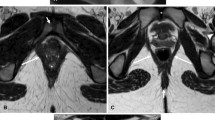Abstract
Purpose
To assess the usefulness of MR defecography in evaluating pelvic floor dysfunction, and to correlate several pelvic organ abnormalities with each other and with patients’ symptoms and characteristics.
Methods
MR defecographic examinations performed in 3T MRI machine of 95 patients (70 females, 25 males; mean age 48) were retrospectively reviewed. Pelvic organ abnormalities from all three compartments were recorded, including the anorectal junction descent, anterior rectocele, and cystocele. These were graded according to the known HMO system in relation to the pubococcygeal line. The correlation between these different abnormalities and their relation to patient symptoms and characteristics were evaluated.
Results
Anorectal junction descent and anterior rectocele were most commonly observed, predominantly manifesting in female patients. Both were associated with abnormalities from all compartments. The middle compartment was the least affected, and its abnormality of uterine/vaginal descent tended to occur in association with the anterior compartment abnormality (cystocele). Anismus was low in incidence, and was not associated with other compartments abnormalities. Both enterocele/peritoneocele and intussusception were uncommon.
Conclusion
MR defecography is the modality of choice in assessing pelvic floor dysfunction, because it can neatly show various pelvic organ abnormalities from all compartments in a dynamic fashion, which are frequently coexistent. It can even show clinically silent or unsuspected abnormalities which can impact the management of patients.



Similar content being viewed by others
References
Olsen A, Smith V, Bergstrom J, et al. (1997) Epidemiology of surgically managed pelvic organ prolapse and urinary incontinence. Obstet Gynecol 89:501–506
Mortele K, Fairhurst J (2006) Dynamic MR defecography of the posterior compartment: indications, techniques and MRI features. Eur J Radiol 61:462–472
Colaiacomo M, Masselli G, Polettini E, et al. (2009) Dynamic MR imaging of the pelvic floor: a pictorial review. Radiographics. doi:10.1148/rg.e35
Maglinte D, Kelvin F, Fitzgerald K, et al. (1999) Association of compartment defects in pelvic floor dysfunction. AJR 172:439–444
Roos J, Weishaupt D, Wildermuth S, et al. (2002) Experience of 4 years with open MR defecography: pictorial review of anorectal anatomy and disease. Radiographics 22:817–832
Goh V, Halligan S, Kaplan G, et al. (2000) Dynamic MR imaging of the pelvic floor in asymptomatic subjects. AJR 174:661–666
Ratz V, Wech T, Schindele A, et al. (2016) Dynamic 3D MR-Defecography. Fortsch Roentgenstr 188:859–863
Boyadzhyan L, Raman S, Raz SH (2008) Role of static and dynamic MR imaging in surgical pelvic floor dysfunction. Radiographics 28:949–967
Reiner C, Tutuian R, Solopova A, et al. (2011) MR defecography in patients with dyssynergic defecation: spectrum of imaging findings and diagnostic value. Br J Radiol 84:136–144
Healy J, Halligan S, Reznek RH (1997) Dynamic MR imaging compared with evacuation proctography when evaluating anorectal configuration and pelvic floor movement. AJR 169:775–779
Li M, Jiang T, Yang X, et al. (2015) Association of compartment defects in anorectal and pelvic floor dysfunction with female outlet obstruction constipation by dynamic MR defecography. Eur Rev Med Pharmacol 19:1407–1415
Thapar R, Patankar R, Kamat R, et al. (2015) MR defecography for obstructed defecation syndrome. Indian J Radiol Imaging 25:25–30
Hendrix S, Clark A, Nygaard I, et al. (2002) Pelvic organ prolapse in the women’s health initiative: gravity and gravidity. Am J Obstet Gynecol 186:1160–1166
Chen H, Iroatulam A, Alabaz O, et al. (2001) Associations of defecography and physiologic findings in male patients with rectocele. Tech Coloproctol 5:157–161
Takahashi T, Yamana T, Sahara R, et al. (2006) Enterocele: what is the clinical implication? Dis Colon Rectum 49:S75–S81
Acknowledgement
We are very thankful to Professor Yousef S Khader for his valuable contribution in the statistical analysis.
Author information
Authors and Affiliations
Corresponding author
Ethics declarations
Funding
No funding was received for this study.
Conflict of interest
The authors declare that they have no conflict of interest.
Ethical approval
All procedures performed in studies involving human participants were in accordance with the ethical standards of the institutional and/or national research committee and with the 1964 Helsinki declaration and its later amendments or comparable ethical standards.
Informed consent
Statement of informed consent was not applicable since the manuscript does not contain any patient data.
Rights and permissions
About this article
Cite this article
Al-Najar, M.S., Ghanem, A.F., AlRyalat, S.A.S. et al. The usefulness of MR defecography in the evaluation of pelvic floor dysfunction: our experience using 3T MRI. Abdom Radiol 42, 2219–2224 (2017). https://doi.org/10.1007/s00261-017-1130-7
Published:
Issue Date:
DOI: https://doi.org/10.1007/s00261-017-1130-7




